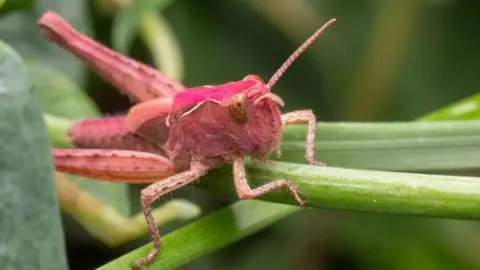Amateur photographer snaps pink grasshopper in Lincoln
 Jak Ward/Macrophotographyuk
Jak Ward/MacrophotographyukAn amateur photographer has spoken of his excitement after capturing a pink grasshopper on camera.
Jak Ward, 31, spotted the garish insect in his garden in Lincoln.
Normally green or brown it is believed occasionally a genetic mutation causes them to turn pink.
Mr Ward, a keen macro photographer, estimated the bug was between 15 and 20mm in length, adding: "I didn't think much of it at first until I looked up how rare seeing one actually is."
"I was pretty excited and grabbed the camera and managed to get a few pictures before it jumped away," he added.
 Jak Ward/Macrophotographyuk
Jak Ward/MacrophotographyukRachel Shaw, from Lincolnshire Wildlife Trust said while unusual pink grasshoppers are not uncommon in England.
"It's great to see a pink grasshopper and can be quite a surprise but they are perhaps more common than people think," she said.
"At this time of year, there are always reports of pink grasshoppers."
She said in some grasshoppers the unusual colouration is caused by a condition called erythrism, which causes the insect's body to produce too much red pigment, others are juveniles that will turn greener and browner as they get older.
Professor Karim Vahed, from conservation charity Buglife, said the Meadow Grasshopper was the species in the UK with the most pink form but Common Green Grasshoppers and Field Grasshoppers could also appear pink.
He added that, as well being easier to spot for humans, being pink "makes them less camouflaged against a green background and could make them more susceptible to being eaten by birds".
Asked about their rarity he said: "Some sources suggest that only a few percent of the Meadow Grasshoppers in a population will be pink/purple [but] if you are in an area where the species is abundant this will obviously increase your chances of seeing one. I do see a few every year."

Follow BBC East Yorkshire and Lincolnshire on Facebook, Twitter, and Instagram. Send your story ideas to [email protected]
